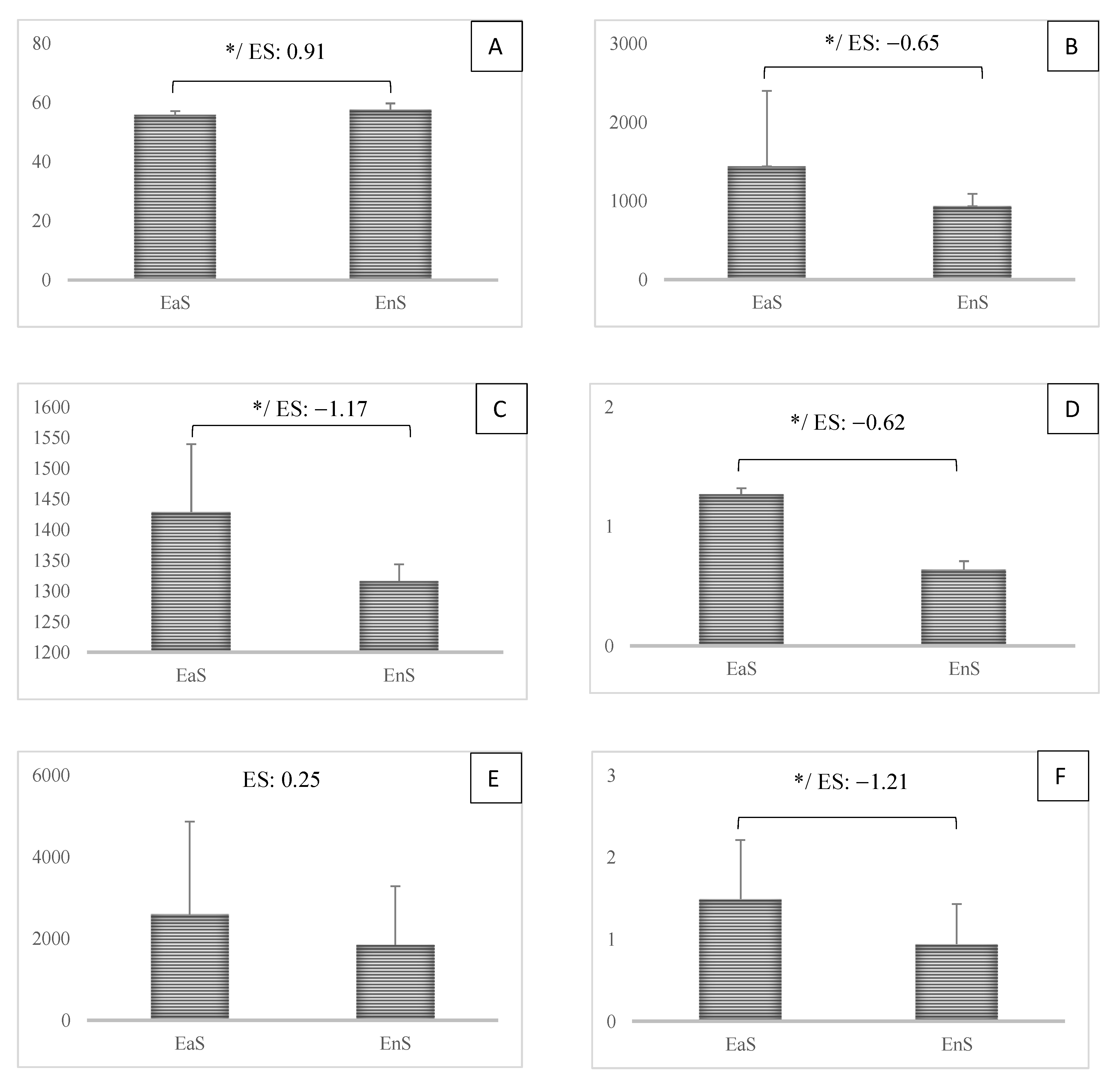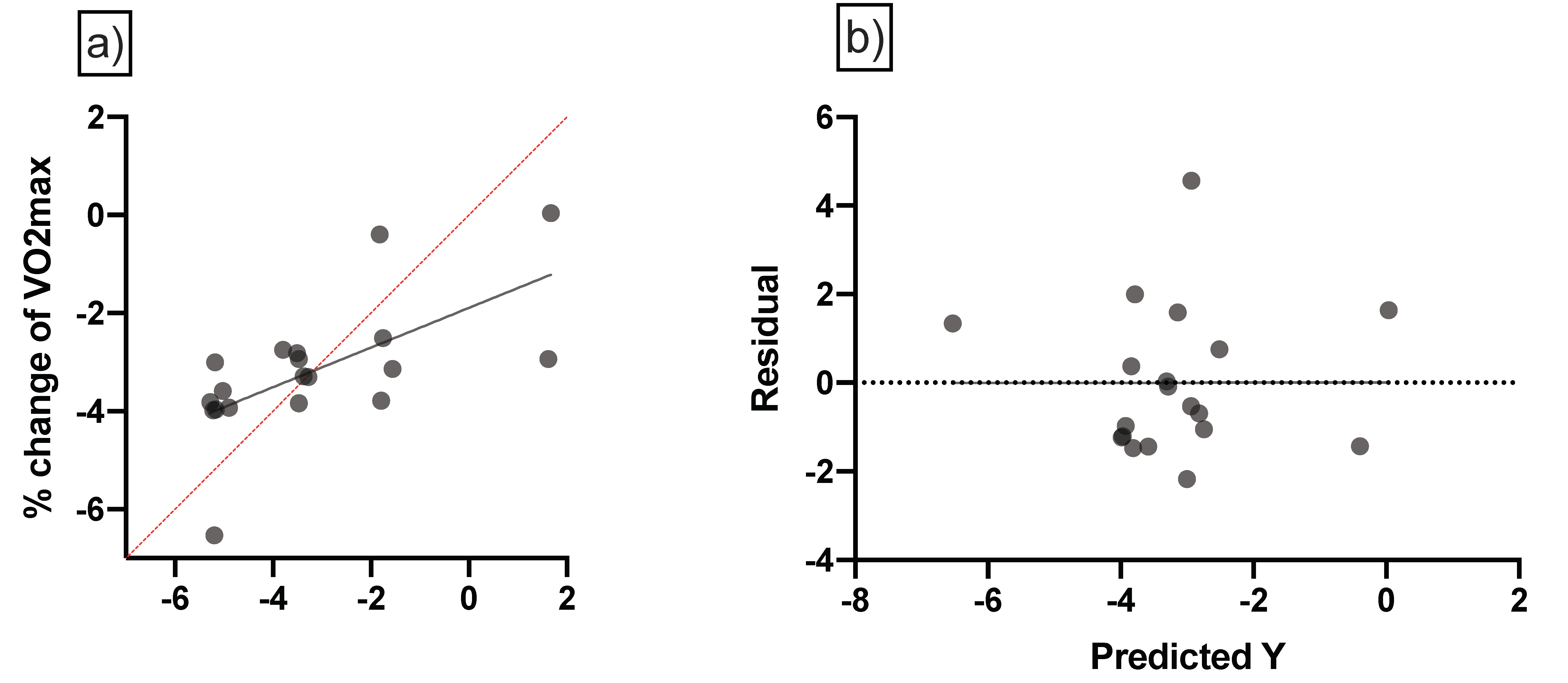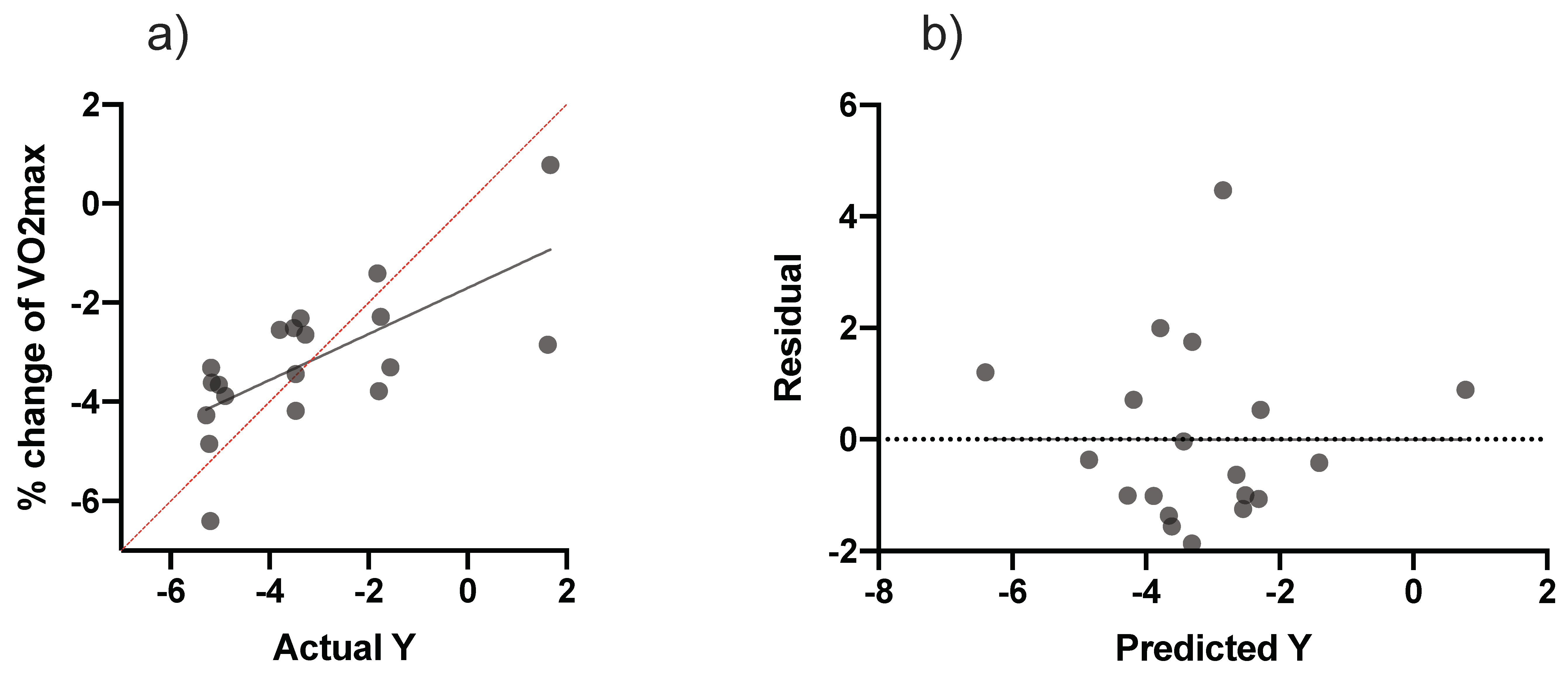Variations in Accumulated-Training Load Parameters and Locomotor Demand with Consideration of Puberty in Elite Young Soccer Players
Abstract
:Simple Summary
Abstract
1. Introduction
2. Materials and Methods
2.1. Participants
2.2. Study Design
2.3. Procedures
2.4. Anthropometrics and Maturation
2.5. Monitoring Training Load
2.6. Locomotor Demand Test
2.7. Statistical Analysis
3. Results
4. Discussion
5. Conclusions
Author Contributions
Funding
Institutional Review Board Statement
Informed Consent Statement
Data Availability Statement
Acknowledgments
Conflicts of Interest
References
- Stølen, T.; Chamari, K.; Castagna, C.; Wisløff, U. Physiology of soccer. Sports Med. 2005, 35, 501–536. [Google Scholar] [CrossRef] [PubMed]
- Forsman, H.; Blomqvist, M.; Davids, K.; Liukkonen, J.; Konttinen, N. Identifying technical, physiological, tactical and psychological characteristics that contribute to career progression in soccer. Int. J. Sports Sci. Coach. 2016, 11, 505–513. [Google Scholar] [CrossRef]
- Mallo, J.; Navarro, E. Physical load imposed on soccer players during small-sided training games. J. Sports Med. Phys. Fit. 2008, 48, 166–171. [Google Scholar]
- Miranda, R.E.E.P.C.; Antunes, H.K.M.; Pauli, J.R.; Puggina, E.F.; da Silva, A.S.R. Effects of 10-week soccer training program on anthropometric, psychological, technical skills and specific performance parameters in youth soccer players. Sci. Sports 2013, 28, 81–87. [Google Scholar] [CrossRef]
- Mohr, M.; Krustrup, P.; Bangsbo, J. Match performance of high-standard soccer players with special reference to development of fatigue. J. Sports Sci. 2003, 21, 519–528. [Google Scholar] [CrossRef] [Green Version]
- Wisloff, U.; Castagna, C.; Helgerud, J.; Jones, R.; Hoff, J. Strong correlation of maximal squat strength with sprint performance and vertical jump height in elite soccer players. Br. J. Sports Med. 2004, 38, 285–288. [Google Scholar] [CrossRef] [PubMed] [Green Version]
- Reilly, T. The Science of Training-Soccer: A Scientific Approach to Developing Strength, Speed and Endurance; Routledge: Oxfordshire, UK, 2006. [Google Scholar]
- Oliveira, R.; Brito, J.P.; Moreno-Villanueva, A.; Nalha, M.; Rico-González, M.; Clemente, F.M. Reference Values for External and Internal Training Intensity Monitoring in Young Male Soccer Players: A Systematic Review. Healthcare 2021, 9, 1567. [Google Scholar] [CrossRef]
- Palucci Vieira, L.H.; Carling, C.; Barbieri, F.A.; Aquino, R.; Santiago, P.R.P. Match Running Performance in Young Soccer Players: A Systematic Review. Sports Med. 2019, 49, 289–318. [Google Scholar] [CrossRef]
- Bangsbo, J.; Mohr, M.; Krustrup, P. Physical and metabolic demands of training and match-play in the elite football player. J. Sports Sci. 2006, 24, 665–674. [Google Scholar] [CrossRef]
- Bishop, D.; Girard, O.; Mendez-Villanueva, A. Repeated-sprint ability—Part II: Recommendations for training. Sports Med. 2011, 41, 741–756. [Google Scholar] [CrossRef]
- Armstrong, N.; Barker, A.R.; McManus, A.M. Muscle metabolism changes with age and maturation: How do they relate to youth sport performance? Br. J. Sports Med. 2015, 49, 860–864. [Google Scholar] [CrossRef] [PubMed]
- Malina, R.M.; Bouchard, C.; Bar-Or, O. Growth, Maturation, and Physical Activity; Human Kinetics: Champaing, IL, USA, 2004. [Google Scholar]
- Malina, R.M. Growth and maturity status of young soccer players. In Science and Soccer, 2nd ed.; Routledge: Oxforshire, UK, 2003; pp. 287–306. [Google Scholar] [CrossRef]
- Mirwald, R.L.; Baxter-Jones, A.D.; Bailey, D.A.; Beunen, G.P. An assessment of maturity from anthropometric measurements. Med. Sci. Sports Exerc. 2002, 34, 689–694. [Google Scholar] [CrossRef] [PubMed]
- Hill, M.; Scott, S.; McGee, D.; Cumming, S.P. Are relative age and biological ages associated with coaches’ evaluations of match performance in male academy soccer players? Int. J. Sports Sci. Coach. 2021, 16, 227–235. [Google Scholar] [CrossRef]
- Nobari, H.; Silva, A.F.; Clemente, F.M.; Siahkouhian, M.; García-Gordillo, M.Á.; Adsuar, J.C.; Pérez-Gómez, J. Analysis of fitness status variations of under-16 soccer players over a season and their relationships with maturational status and training load. Front. Physiol. 2021, 11, 1840. [Google Scholar] [CrossRef]
- Beunen, G.; Ostyn, M.; Simons, J.; Renson, R.; Van Gerven, D. Chronological and biological age as related to physical fitness in boys 12 to 19 years. Ann. Hum. Biol. 1981, 8, 321–331. [Google Scholar] [CrossRef]
- Vaeyens, R.; Lenoir, M.; Williams, A.M.; Philippaerts, R.M. Talent identification and development programmes in sport. Sports Med. 2008, 38, 703–714. [Google Scholar] [CrossRef]
- Murtagh, C.F.; Brownlee, T.E.; O’Boyle, A.; Morgans, R.; Drust, B.; Erskine, R.M. Importance of Speed and Power in Elite Youth Soccer Depends on Maturation Status. J. Strength Cond. Res. 2018, 32, 297–303. [Google Scholar] [CrossRef] [Green Version]
- Peña-González, I.; Fernández-Fernández, J.; Cervelló, E.; Moya-Ramón, M. Effect of biological maturation on strength-related adaptations in young soccer players. PLoS ONE 2019, 14, e0219355. [Google Scholar] [CrossRef]
- Eskandarifard, E.; Silva, R.; Nobari, H.; Clemente, F.M.; Pérez-Gómez, J.; Figueiredo, A.J. Maturational effect on physical capacities and anabolic hormones in under-16 elite footballers: A cross-sectional study. Sport Sci. Health 2022, 18, 297–305. [Google Scholar] [CrossRef]
- Clemente, F.M.; Mendes, B.; Bredt, S.; Praca, G.M.; Silverio, A.; Carrico, S.; Duarte, E. Perceived Training Load, Muscle Soreness, Stress, Fatigue, and Sleep Quality in Professional Basketball: A Full Season Study. J. Hum. Kinet. 2019, 67, 199–207. [Google Scholar] [CrossRef]
- Clemente, F.M.; Silva, R.; Castillo, D.; Los Arcos, A.; Mendes, B.; Afonso, J. Weekly Load Variations of Distance-Based Variables in Professional Soccer Players: A Full-Season Study. Int. J. Environ. Res. Public Health 2020, 17, 3300. [Google Scholar] [CrossRef] [PubMed]
- Nobari, H.; Alves, A.R.; Clemente, F.M.; Pérez-Gómez, J.; Clark, C.C.T.; Granacher, U.; Zouhal, H. Associations Between Variations in Accumulated Workload and Physiological Variables in Young Male Soccer Players Over the Course of a Season. Front. Physiol. 2021, 12, 638180. [Google Scholar] [CrossRef] [PubMed]
- Bowen, L.; Gross, A.S.; Gimpel, M.; Li, F.-X. Accumulated workloads and the acute: Chronic workload ratio relate to injury risk in elite youth football players. Br. J. Sports Med. 2017, 51, 452–459. [Google Scholar] [CrossRef] [PubMed] [Green Version]
- Salter, J.; De Ste Croix, M.B.A.; Hughes, J.D.; Weston, M.; Towlson, C. Monitoring Practices of Training Load and Biological Maturity in UK Soccer Academies. Int. J. Sports Physiol. Perform. 2021, 16, 395–406. [Google Scholar] [CrossRef]
- Teixeira, J.E.; Forte, P.; Ferraz, R.; Leal, M.; Ribeiro, J.; Silva, A.J.; Barbosa, T.M.; Monteiro, A.M. Monitoring accumulated training and match load in football: A systematic review. Int. J. Environ. Res. Public Health 2021, 18, 3906. [Google Scholar] [CrossRef]
- Nobari, H.; Ramachandran, A.K.; Moreira, M.; Khani, S.; Khezri, D.; Mainer-Pardos, E. Relationship between Variations in the Accumulated Workload and the Change of Direction Ability in Elite Young Soccer Players. Sustainability 2022, 14, 5535. [Google Scholar] [CrossRef]
- Borg, G. Borg’s Perceived Exertion and Pain Scales; Human Kinetics: Champaing, IL, USA, 1998. [Google Scholar]
- Dalen-Lorentsen, T.; Bjørneboe, J.; Clarsen, B.; Vagle, M.; Fagerland, M.W.; Andersen, T.E. Does load management using the acute:chronic workload ratio prevent health problems? A cluster randomised trial of 482 elite youth footballers of both sexes. Br. J. Sports Med. 2021, 55, 108–114. [Google Scholar] [CrossRef]
- Buchheit, M. The 30-15 intermittent fitness test: Accuracy for individualizing interval training of young intermittent sport players. J. Strength Cond. Res. 2008, 22, 365–374. [Google Scholar] [CrossRef] [Green Version]
- Cohen, P.; West, S.G.; Aiken, L.S. Applied Multiple Regression/Correlation Analysis for the Behavioral Sciences; Psychology Press: London, UK, 2014. [Google Scholar]
- Hopkins, W.G.; Marshall, S.W.; Batterham, A.M.; Hanin, J. Progressive Statistics for Studies in Sports Medicine and Exercise Science. Med. Sci. Sports Exerc. 2009, 41, 3–12. [Google Scholar] [CrossRef] [Green Version]
- Hammami, M.A.; Ben Abderrahman, A.; Rhibi, F.; Nebigh, A.; Coppalle, S.; Rave, G.; Tabka, Z.; Zouhal, H. Somatotype Hormone Levels and Physical Fitness in Elite Young Soccer Players over a Two-Year Monitoring Period. J. Sports Sci. Med. 2018, 17, 455–464. [Google Scholar]
- Goto, H.; Morris, J.G.; Nevill, M.E. Influence of Biological Maturity on the Match Performance of 8- to 16-Year-Old, Elite, Male, Youth Soccer Players. J. Strength Cond. Res. 2019, 33, 3078–3084. [Google Scholar] [CrossRef] [PubMed]
- John, C.; Rahlf, A.L.; Hamacher, D.; Zech, A. Influence of biological maturity on static and dynamic postural control among male youth soccer players. Gait Posture 2019, 68, 18–22. [Google Scholar] [CrossRef] [PubMed]
- Figueiredo, A.J.; Coelho, E.S.M.J.; Cumming, S.P.; Malina, R.M. Size and maturity mismatch in youth soccer players 11- to 14-years-old. Pediatr. Exerc. Sci. 2010, 22, 596–612. [Google Scholar] [CrossRef] [PubMed]
- Malina, R.M.; Rogol, A.D.; Cumming, S.P.; Coelho e Silva, M.J.; Figueiredo, A.J. Biological maturation of youth athletes: Assessment and implications. Br. J. Sports Med. 2015, 49, 852–859. [Google Scholar] [CrossRef] [PubMed] [Green Version]
- Beunen, G.P.; Malina, R.M.; Renson, R.; Simons, J.; Ostyn, M.; Lefevre, J. Physical activity and growth, maturation and performance: A longitudinal study. Med. Sci. Sports Exerc. 1992, 24, 576–585. [Google Scholar] [CrossRef]
- Beunen, G.; Malina, R.M. Growth and physical performance relative to the timing of the adolescent spurt. Exerc. Sport Sci. Rev. 1988, 16, 503–540. [Google Scholar] [CrossRef]
- Philippaerts, R.M.; Vaeyens, R.; Janssens, M.; Van Renterghem, B.; Matthys, D.; Craen, R.; Bourgois, J.; Vrijens, J.; Beunen, G.; Malina, R.M. The relationship between peak height velocity and physical performance in youth soccer players. J. Sports Sci. 2006, 24, 221–230. [Google Scholar] [CrossRef]
- Nobari, H.; Ceylan, H.İ.; Khani, S.; Öztürk, M.E.; Mainer-Pardos, E. Relationship Between Variations Accumulated Workload and Sprint Performance in Elite Adolescent Soccer Players. JOMH 2022, 18. [Google Scholar] [CrossRef]
- Clemente, F.M.; Silva, A.F.; Kawczynski, A.; Yildiz, M.; Chen, Y.S.; Birlik, S.; Nobari, H.; Akyildiz, Z. Physiological and locomotor demands during small-sided games are related to match demands and physical fitness? A study conducted on youth soccer players. BMC Sports Sci Med Rehabil 2022, 14, 138. [Google Scholar] [CrossRef]
- Sarmento, H.; Anguera, M.T.; Pereira, A.; Araujo, D. Talent Identification and Development in Male Football: A Systematic Review. Sports Med. 2018, 48, 907–931. [Google Scholar] [CrossRef]
- Buekers, M.; Borry, P.; Rowe, P. Talent in sports. Some reflections about the search for future champions. Mov. Sport Sci. 2015, 88, 3. [Google Scholar] [CrossRef]
- Chumela, W.C.; Roche, A.F.; Thissen, D. The FELS method of assessing the skeletal maturity of the hand-wrist. Am. J. Hum. Biol. 1989, 1, 175–183. [Google Scholar] [CrossRef] [PubMed]
- Eliakim, A.; Nemet, D. Exercise training, physical fitness and the growth hormone-insulin-like growth factor-1 axis and cytokine balance. Med. Sport Sci. 2010, 55, 128–140. [Google Scholar] [CrossRef] [PubMed]



| Variables | Before League | 1st Half | 2nd Half | After League | Total |
|---|---|---|---|---|---|
| Weeks (n) | 1 | 8 | 7 | 1 | 17 |
| Training sessions (n) | 4 | 30 | 23 | 2 | 59 |
| Matches (n) | - | 8 | 8 | - | 16 |
| Variable | MO | VO2max1 | VO2max2 | AWL1 | AWL2 | CWL1 | CWL2 | ACWR1 | ACWR2 | TM1 | TM2 | TS1 | TS2 |
|---|---|---|---|---|---|---|---|---|---|---|---|---|---|
| MO | 1 | ||||||||||||
| VO2max1 | −0.06 | 1 | |||||||||||
| VO2max2 | −0.19 | 0.85 ** | 1 | ||||||||||
| AWL1 | 0.02 | −0.03 | −0.06 | 1 | |||||||||
| AWL2 | 0.12 | 0.12 | 0.32 | 0.05 | 1 | ||||||||
| CWL1 | 0.14 | 0.37 | 0.29 | 0.19 | 0.13 | 1 | |||||||
| CWL2 | 0.01 | −0.01 | 0.13 | −0.08 | 0.56 | −0.08 | 1 | ||||||
| ACWR1 | −0.05 | −0.08 | −0.02 | −0.25 | −0.13 | −0.59 ** | −0.06 | 1 | |||||
| ACWR2 | 0.11 | 0.05 | 0.14 | 0.03 | −0.05 | 0.18 | 0.41 * | −0.13 | 1 | ||||
| TM1 | 0.17 | −0.01 | −0.13 | 0.47 * | 0.01 | 0.36 | 0.05 | −0.29 | 0.23 | 1 | |||
| TM2 | −0.03 | −0.23 | −0.38 | 0.09 | 0.04 | 0.09 | −0.08 | −0.10 | −0.03 | 0.04 | 1 | ||
| TS1 | 0.19 | −0.09 | −0.26 | 0.48 | 0.05 | 0.40 * | 0.01 | −0.37 * | 0.19 | 0.96 ** | 0.04 | 1 | |
| TS2 | 0.06 | 0.13 | 0.35 | 0.07 | 0.16 | −0.13 | 0.51 ** | −0.17 | −0.01 | −0.01 | 0.01 | 0.16 | 1 |
| Variable | PHV | VO2max1 | VO2max2 | AWL1 | AWL2 | CWL1 | CWL2 | ACWR1 | ACWR2 | TM1 | TM2 | TS1 | TS2 |
|---|---|---|---|---|---|---|---|---|---|---|---|---|---|
| PHV | 1 | ||||||||||||
| VO2max1 | −0.01 | 1 | |||||||||||
| VO2max2 | 0.04 | 0.85 ** | 1 | ||||||||||
| AWL1 | −0.07 | −0.12 | 0.11 | 1 | |||||||||
| AWL2 | −0.09 | −0.01 | 0.10 | 0.04 | 1 | ||||||||
| CWL1 | −0.07 | 0.36 | 0.28 | 0.22 | 0.10 | 1 | |||||||
| CWL2 | 0.12 | 0.20 | 0.23 | −0.07 | 0.62 ** | −0.09 | 1 | ||||||
| ACWR1 | −0.08 | −0.06 | −0.21 | −0.29 | −0.08 | −0.53 ** | −0.06 | 1 | |||||
| ACWR2 | −0.03 | −0.03 | −0.05 | 0.05 | 0.83 ** | 0.15 | 0.49 ** | −0.18 | 1 | ||||
| TM1 | 0.01 | −0.11 | −0.09 | −0.54 ** | −0.03 | 0.32 * | 0.05 | −0.29 | 0.05 | 1 | |||
| TM2 | 0.08 | −0.18 | −0.21 | −0.06 | 0.03 | 0.16 | −0.09 | −0.10 | −0.01 | 0.04 | 1 | ||
| TS1 | −0.17 | −0.05 | −0.11 | 0.34 * | −0.12 | 0.54 ** | −0.13 | 0.34 * | 0.08 | 0.02 | 0.16 | 1 | |
| TS2 | −0.03 | 0.02 | 0.18 | 0.18 | 0.34 * | −0.12 | 0.51 ** | −0.18 | 0.34 | 0.09 | 0.00 | −0.16 | 1 |
| Variables | Beta | Estimate | |t| | p | Estimate (95% CI) | TP |
|---|---|---|---|---|---|---|
| VO2max (%) | β0 | −8.258 | 0.79 | 0.44 | −30.5. 13.9 | R2: 0.46 Estimated R2: 0.35 p: 0.02 AIC value: 30.67 |
| CWL (A.U.) | β1 | −0.125 | 0.20 | 0.84 | −0.001. 0.001 | |
| TM (A.U.) | β2 | −0.358 | 1.60 | 0.13 | −0.83. 0.11 | |
| Maturity offset (yr) | β3 | 0.917 | 1.35 | 0.19 | −0.53. 2.36 |
| Variables | Beta | Estimate | |t| | p | Estimated (95% CI) | TP |
|---|---|---|---|---|---|---|
| VO2max (%) | β0 | 6.224 | 1.580 | 0.13 | −2.172. 14.6 | R2: 0.41 Estimated R2: 0.28 p: 0.045 AIC value: 32.68 |
| ACWR (A.U.) | β1 | −0.201 | 0.51 | 0.61 | −1.025. 0.623 | |
| TM (A.U.) | β2 | −0.355 | 2.41 | 0.02 | −0.669. 0.041 | |
| PHV (yr) | β3 | −0.145 | 0.22 | 0.82 | −1.50. 1.21 |
Publisher’s Note: MDPI stays neutral with regard to jurisdictional claims in published maps and institutional affiliations. |
© 2022 by the authors. Licensee MDPI, Basel, Switzerland. This article is an open access article distributed under the terms and conditions of the Creative Commons Attribution (CC BY) license (https://creativecommons.org/licenses/by/4.0/).
Share and Cite
Nobari, H.; shemshaki, H.K.; Kamiş, O.; Oliveira, R.; González, P.P.; Mainer-Pardos, E. Variations in Accumulated-Training Load Parameters and Locomotor Demand with Consideration of Puberty in Elite Young Soccer Players. Biology 2022, 11, 1594. https://doi.org/10.3390/biology11111594
Nobari H, shemshaki HK, Kamiş O, Oliveira R, González PP, Mainer-Pardos E. Variations in Accumulated-Training Load Parameters and Locomotor Demand with Consideration of Puberty in Elite Young Soccer Players. Biology. 2022; 11(11):1594. https://doi.org/10.3390/biology11111594
Chicago/Turabian StyleNobari, Hadi, Hamed Kia shemshaki, Okan Kamiş, Rafael Oliveira, Pablo Prieto González, and Elena Mainer-Pardos. 2022. "Variations in Accumulated-Training Load Parameters and Locomotor Demand with Consideration of Puberty in Elite Young Soccer Players" Biology 11, no. 11: 1594. https://doi.org/10.3390/biology11111594
APA StyleNobari, H., shemshaki, H. K., Kamiş, O., Oliveira, R., González, P. P., & Mainer-Pardos, E. (2022). Variations in Accumulated-Training Load Parameters and Locomotor Demand with Consideration of Puberty in Elite Young Soccer Players. Biology, 11(11), 1594. https://doi.org/10.3390/biology11111594











